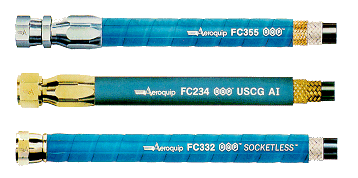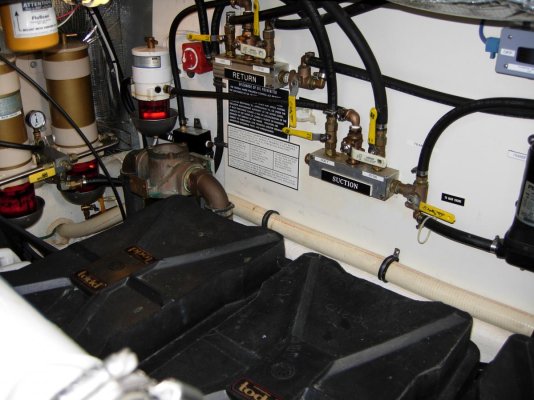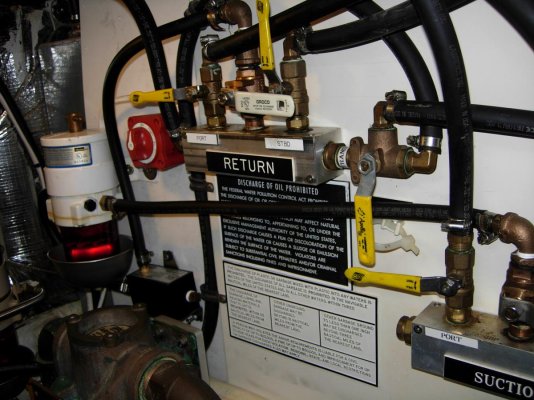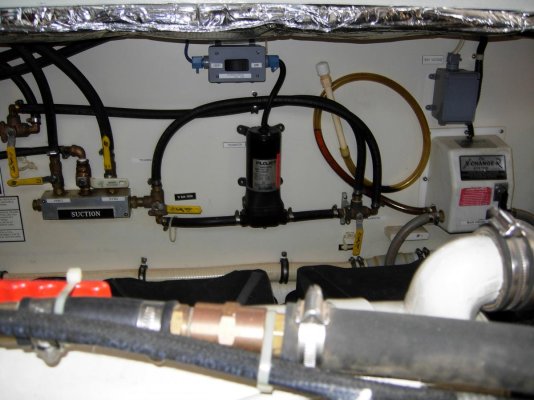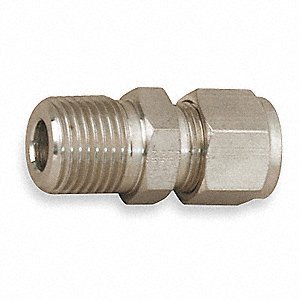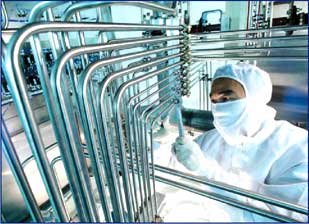are there any preferences for the type of material that diesel fuel lines should be made of? I presently have copper tubing but it looks very dirty - accumulations of crud on the bottom. If I replace the fuel lines, should I replace with copper tubing or the appropriate fuel hose?
You are using an out of date browser. It may not display this or other websites correctly.
You should upgrade or use an alternative browser.
You should upgrade or use an alternative browser.
diesel fuel lines
- Thread starter KDA
- Start date
The friendliest place on the web for anyone who enjoys boating.
If you have answers, please help by responding to the unanswered posts.
If you have answers, please help by responding to the unanswered posts.
Airstream345
Guru
- Joined
- Jul 3, 2017
- Messages
- 1,015
- Location
- United States
- Vessel Name
- FORTITUDE
- Vessel Make
- Kadey Krogen 54-8
following
O C Diver
Guru
- Joined
- Dec 16, 2010
- Messages
- 12,868
- Location
- USA
- Vessel Name
- Slow Hand
- Vessel Make
- Cherubini Independence 45
I chose USCG approved rubber fuel line approved for diesel fuel during my refit (replace all as it was 14 years old). In the event that I own the boat 15 years from now, I'll replace it again. Once you switch to rubber hose, if you ever have to replace it again, cost and time involved will be very minimal. I have seen copper lines for steering fail, presumably from vibration. No way to know the condition until they fail. With hose you can visually check for cracks and flex it to see how brittle it's getting.
Ted
Ted
Comodave
Moderator Emeritus
- Joined
- Jul 2, 2015
- Messages
- 21,284
- Location
- Au Gres, MI
- Vessel Name
- Black Dog
- Vessel Make
- Formula 41PC
Use the proper approved rubber hose.
boomerang
Guru
- Joined
- Apr 29, 2016
- Messages
- 1,398
- Location
- united states
- Vessel Name
- Wandering Star
- Vessel Make
- PSN40
Clean,bright-colored rubber hose looks pretty but takes up more space & has much less of a bend radius than copper. Done in a neat fashion ,copper looks nice in the engine room,too. I would have to imagine copper has less fuel flow restriction verses rubber-walled hose. That said, I'll make due with the 5/16" supply & return lines in our boat and if ,in the future,we need/decide to repower & the engine manufacturer calls for larger diameter lines, I'm sure it will be hose with which the lines get replaced.
FF
Guru
- Joined
- Oct 12, 2007
- Messages
- 22,552
Have used both , rubber is easier and quicker.
Purchase the screw on fittings , rather than the store sweged on and you can make repairs easily.
That said on building a new boat I would use either steel tubing or small diameter steel pipe , mount it , paint it and forget it.
Purchase the screw on fittings , rather than the store sweged on and you can make repairs easily.
That said on building a new boat I would use either steel tubing or small diameter steel pipe , mount it , paint it and forget it.
angus99
Guru
I chose USCG approved rubber fuel line approved for diesel fuel during my refit (replace all as it was 14 years old). In the event that I own the boat 15 years from now, I'll replace it again. Once you switch to rubber hose, if you ever have to replace it again, cost and time involved will be very minimal. I have seen copper lines for steering fail, presumably from vibration. No way to know the condition until they fail. With hose you can visually check for cracks and flex it to see how brittle it's getting.
Ted
Ted, do you happen to have any pix of your fuel lines you could post? I’m especially interested in how hoses look coming off a fuel distribution manifold.
Like many here, I suspect, I have 30-year-old copper lines. Lots of tight bends particularly off the manifold. I need to replace one from the polisher that is badly crimped and I have my doubts about a few others.
Have used both , rubber is easier and quicker.
Purchase the screw on fittings , rather than the store sweged on and you can make repairs easily.
That said on building a new boat I would use either steel tubing or small diameter steel pipe , mount it , paint it and forget it.
Fred, do you have a link or photo of the screw-ons you’re suggesting?
Pack Mule
TF Site Team
- Joined
- Jan 24, 2013
- Messages
- 3,749
- Location
- USA
- Vessel Name
- Slo-Poke
- Vessel Make
- Jorgensen custom 44
Fred may be talking about screw on reusable fittings and hose for fuel line, like the kind for hydraulic.Ted, do you happen to have any pix of your fuel lines you could post? I’m especially interested in how hoses look coming off a fuel distribution manifold.
Like many here, I suspect, I have 30-year-old copper lines. Lots of tight bends particularly off the manifold. I need to replace one from the polisher that is badly crimped and I have my doubts about a few others.
Fred, do you have a link or photo of the screw-ons you’re suggesting?
Last edited:
angus99
Guru
Fred may be talking about screw on reusable fittings and hose for fuel line, like the kind for hydraulic.
Thanks, Marty. I’ll look them up. Just not clear on how they connect to the hose without swaging.
psneeld
Guru
Thanks, Marty. I’ll look them up. Just not clear on how they connect to the hose without swaging.
they screw on ...there is a fitting that goes inside the hose, and the outer fitting scews on and compresses everything. no swagong necessary and they are reusable.
an alternative is the press to fit> Parker blue hose and use a hose clamp yo met ABYC.
O C Diver
Guru
- Joined
- Dec 16, 2010
- Messages
- 12,868
- Location
- USA
- Vessel Name
- Slow Hand
- Vessel Make
- Cherubini Independence 45
Ted, do you happen to have any pix of your fuel lines you could post? I’m especially interested in how hoses look coming off a fuel distribution manifold.
Like many here, I suspect, I have 30-year-old copper lines. Lots of tight bends particularly off the manifold. I need to replace one from the polisher that is badly crimped and I have my doubts about a few others.
All hose clamps are stepless (lined) so the worm and slots don't come in contact with the hose. All hangers are lined or plastic. PVC electrical conduit hangers come in many sizes, are inexpensive, and work great for hose and electrical wiring.

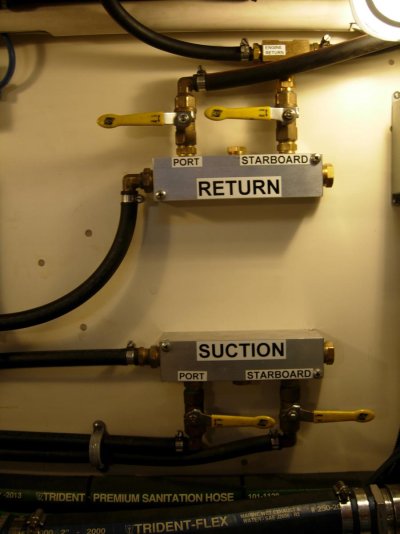
Ted
Maerin
Guru
Parker 221FR hose is the blue hose typically used in marine fuel applications. It is expensive. It has the USCG A1 embossed on the outer jacket. Any hose you use for fuel must carry that A1 USCG rating, a surveyor can ding you if it's not A1.

The fittings other posts have described are series 20. They are field attachable, two piece. If you read the fine print, 221FR hose is supposed to use series 26 fittings (require a hydraulic crimp) to fully meet the A1 spec, but I've never heard of a surveyor calling that out. The series 20 fittings are commonly used, they are easy to make up with a vise and wrenches. The hose can be cut with a cutoff wheel, hacksaw works but makes a messy cut.
Keep in mind that anything supported over an engine must be a metallic support, in a fire it won't let go. So the best way to fasten the hose is the rubber lined stainless pipe band.

The fittings other posts have described are series 20. They are field attachable, two piece. If you read the fine print, 221FR hose is supposed to use series 26 fittings (require a hydraulic crimp) to fully meet the A1 spec, but I've never heard of a surveyor calling that out. The series 20 fittings are commonly used, they are easy to make up with a vise and wrenches. The hose can be cut with a cutoff wheel, hacksaw works but makes a messy cut.
Keep in mind that anything supported over an engine must be a metallic support, in a fire it won't let go. So the best way to fasten the hose is the rubber lined stainless pipe band.
Mr. Blu
Senior Member
- Joined
- Jun 11, 2017
- Messages
- 147
- Location
- The Netherlands
- Vessel Name
- Mr. Blu
- Vessel Make
- Beneteau Swift Trawler 52
In Europe diesel fuel lines must be double clamped (AND OPPOSITE) on each side. Does this obligation not apply in the US?
FF
Guru
- Joined
- Oct 12, 2007
- Messages
- 22,552
Fred may be talking about screw on reusable fittings and hose for fuel line, like the kind for hydraulic.
When you visit the store to buy the hose , they will happily provide either crimp on or screw on fittings.
When you visit the store to buy the hose , they will happily provide either crimp on or screw on fittings.
Tom.B
Moderator Emeritus
- Joined
- Jul 30, 2009
- Messages
- 5,839
- Location
- USA
- Vessel Name
- Skinny Dippin'
- Vessel Make
- Navigator 4200 Classic
All hose clamps are stepless (lined) so the worm and slots don't come in contact with the hose. All hangers are lined or plastic. PVC electrical conduit hangers come in many sizes, are inexpensive, and work great for hose and electrical wiring.
View attachment 72743
View attachment 72744
Ted
As a side note... What a lovely fuel rig. Simple and neat.

Tom.B
Moderator Emeritus
- Joined
- Jul 30, 2009
- Messages
- 5,839
- Location
- USA
- Vessel Name
- Skinny Dippin'
- Vessel Make
- Navigator 4200 Classic
following
For the record: You can subscribe to a thread without having to post in the thread itself if you like. At the top of the page under 'Thread Tools' there is a drop-down menu where you can select 'Subscribe to this thread'
Just a quick FYI

O C Diver
Guru
- Joined
- Dec 16, 2010
- Messages
- 12,868
- Location
- USA
- Vessel Name
- Slow Hand
- Vessel Make
- Cherubini Independence 45
Don't believe it applies in the USA. Certainly nothing wrong with it, but not really necessary on the vacuum side. Pressure side probably doesn't see 3 psi. Obviously everything that sees elevated fuel pressures on the engine is metal tubing.In Europe diesel fuel lines must be double clamped (AND OPPOSITE) on each side. Does this obligation not apply in the US?
Ted
FF
Guru
- Joined
- Oct 12, 2007
- Messages
- 22,552
Rubber hose tends to look crappy ( as does some wiring) because it sags between support points.
A piece of dowel next to the hose , and wire ties can make a big difference.
A piece of dowel next to the hose , and wire ties can make a big difference.
Mr. Blu
Senior Member
- Joined
- Jun 11, 2017
- Messages
- 147
- Location
- The Netherlands
- Vessel Name
- Mr. Blu
- Vessel Make
- Beneteau Swift Trawler 52
I was referring to the pictures of OC Diver, where just are single clamps on all the fuel lines.
latravcha
Senior Member
boomerang
Guru
- Joined
- Apr 29, 2016
- Messages
- 1,398
- Location
- united states
- Vessel Name
- Wandering Star
- Vessel Make
- PSN40
Why not use 316 stainless tubing and fittings?
We use it at work for all sorts of things.
You can get a 20' joint for about $35 and the fittings are about 10 each.
It is not hard to bend. I think it would be a lifetime fix and it would look good.
View attachment 72784
View attachment 72785
Stainless is good for dairy products but a no-no in the engine room regarding fuel supply & transfer. Get ready for a severe scolding Latracha!

